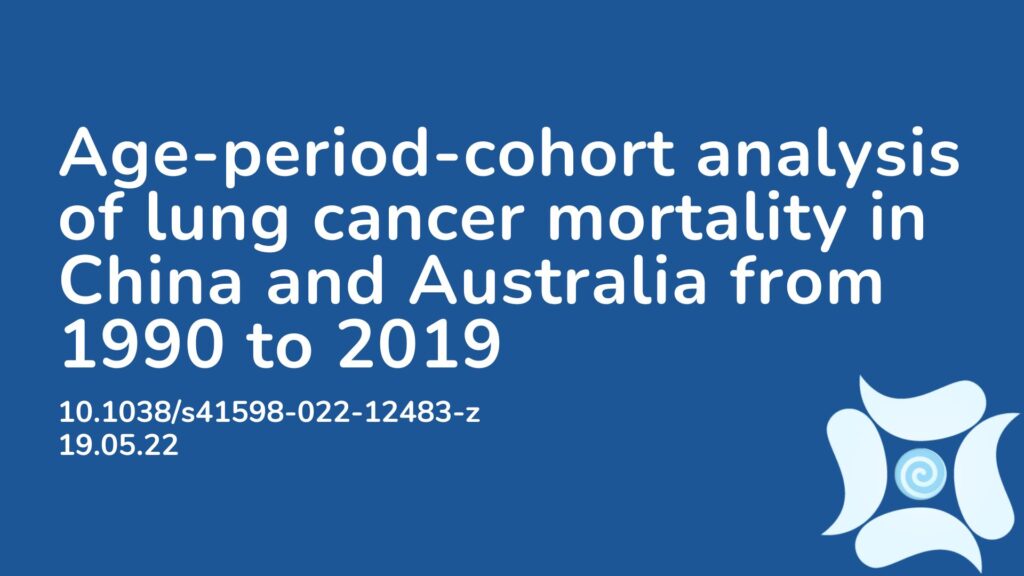Summary: This cohort analysis aimed to look at the trends of lung cancer (LC) mortality in Australia and China, the two largest countries in the Western Pacific Region, by examining LC rates and its relationship to age and time period from 1990 to 2019 in Australia and China. The purpose of this comparative analysis is to understand the drivers of LC, inform future public health decisions and evaluate current ones, plus draw lessons for other countries in the region. The main contributing factors to LC that are looked at in this paper are tobacco use, particulate matter (PM) also known as pollution and carcinogens. The paper showed that tobacco use in Chinese men is much higher than Australian men, however tobacco use in Chinese women is lower than that in Australian women. Tobacco use was the most prevalent risk factor associated with LC in both countries and PM and carcinogens were second. The level of pollution concentration in Australia is considerably lower than China’s exposures and it stays within the public health daily guidelines. Interestingly, although energy consumption and the number of vehicles have increased over the last two decades in Australia, PM concentrations have still declined. It is thought that this can be explained by the introduction of emission reduction strategies and policies for vehicles and power generation in Australia – a public health intervention that has seemingly been effective. However, given the depth of urbanisation and presence of climate change in Australia, it will be challenging to further reduce PM levels. This paper also showed that long-term exposure to carcinogens in the workplace such as asbestos was associated with 9% to 15% of LC rates. LC rates attributable to occupational carcinogens among the Chinese population over 60 years old was lower than the Australian cohort of the same age, although Australian trends are showing it is lowering. In 2003, Australia completely banned the use of asbestos. Despite these results, it is clear that Australia has seen a significant reduction in LC when assessing over time, particularly for those attributable to smoking. There are clear correlations between the public interventions on smoking, pollution and asbestos that were strictly implemented in Australia in the last two decades, which could very well explain the reduction in LC rates. This suggests that more stringent control strategies for tobacco use, pollutants and carcinogens in China would ease the heavy burden of LC mortality in China and other similar countries in the region.
Abstract: Lung cancer (LC) is the leading cause of cancer death in China and Australia, the countries with different socio environmental contexts in the Western Pacific Region. Comparing the age-period-cohort effect on LC mortality (LCM) between the two countries can help plan interventions and draw lessons for countries in the region. We collected LCM estimates between 1990 and 2019 from the GBD 2019. Age-period-cohort modelling was applied to compute the net drift, local drift, cross-sectional age curve, longitudinal age curve, and the rate ratios (RRs) of period and cohort. China had a higher LC age-standardized mortality rate than Australia in 2019 (men: 58.10 [95% uncertainty interval (UI): 46.53, 70.89] vs. 30.13 [95% UI: 27.88, 32.31]/100,000 population; women: 22.86 [95% UI: 18.52, 27.52] vs. 17.80 [95% UI: 15.93, 19.34]/100,000 population). Period and cohort effects on LCM improved more markedly among Australian men (RR for period effect, from 1.47 [95% confidence interval (CI) 1.41, 1.53] to 0.79 [95% CI 0.75, 0.84]; RR for cohort effect, from 2.56 [95% CI 2.44, 2.68] to 0.36 [95% CI 0.11, 1.18]) and Chinese women (RR for period effect, from 1.06 [95% CI 1.01, 1.11] to 0.85 [95% CI 0.82, 0.89]; RR for cohort effect, from 0.71 [95% CI 0.65, 0.78] to 0.51 [95% CI 0.26, 1.03]) during the study period and birth cohort. The LCM in Chinese population aged 65 to 79 and Australian women aged 75 to 79 increased. Smoking and particulate matter (PM) contributed most to LCM in China, while smoking and occupational carcinogens contributed most in Australia. Decreasing period and cohort risks for LCM attributable to smoking and PM were more remarkable in Australia than in China. The LCM attributable to occupational carcinogens was higher in Australia than in China, particularly for those aged 60 to 79. Vigorous tobacco and PM control, which brought a substantial decline in LCM in Australia, may help reduce LCM in China. Australia should highlight LC prevention among people with occupational exposure. Chinese aged ≥ 65 and Australian women aged ≥ 75 should be the priorities for LC interventions.
Article Publication Date: 19.05.22
DOI: 10.1038/s41598-022-12483-z



